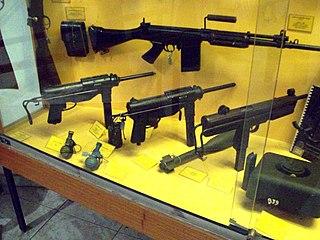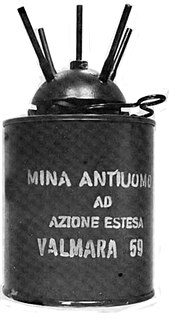Related Research Articles
The GATOR mine system is a United States military system of air-dropped anti-tank and anti-personnel mines developed in the 1980s to be compatible with existing cluster dispensers. It is used with two dispenser systems—the Navy 230 kg (500 lb) CBU-78/B and the Air Force 450 kg (1,000 lb) CBU-89/B. Additionally the mines are used with the land- and helicopter-based Volcano mine system.

PFM-1 is a land mine of Soviet production, very similar to the BLU-43 landmine used by the US Army. Both devices are very similar in shape and principles, although they use different explosives.
The PT Mi-Ba-II is a large Bakelite cased Czechoslovakian anti-tank blast mine. The mine is unusual in that it has two plunger fuses instead of a pressure plate. The plunger fuses give the mine resistance to overpressure, also the plastic body makes it difficult to detect.
The M7 is a small, metal-cased United States anti-tank blast mine that was used during the Second World War. It was based on the British Hawkins grenade. Approximately 2.5 million were produced before production ceased, and although it has long since been withdrawn from U.S. service, it can be found in Angola, Burma, Cambodia, Chad, Eritrea, Ethiopia, Korea, Lebanon, Myanmar, Somalia, Thailand, and Zambia.
The Expal C-3-A and C-3-B are round Spanish rubber modified polystyrene cased anti-tank blast mines. The mines differ only in minor detail. The mine is classified as a minimum metal mine, the only metal it contains being a 4.5 millimetre diameter zinc-plated steel spring. The mine is found in Angola, the Falkland Islands, and the Western Sahara. The mines are vulnerable to the plastic cases deteriorating in bright sunlight, resulting in a reduction in activation pressure.

The FMK-3 is a fibreglass cased Argentine anti-tank blast mine. It is produced by Direccion General de Fabricaciones Militares. The mine actually uses a FMK-1 anti-personnel mine as a fuze, the FMK-1 is modified with a pressure cap to increase the activation pressure. Argentina's stock of FMK-1 mines was modified in 2003 to prevent their use as anti-personnel mines, this involved welded an additional plastic pressure cap onto the mine. The mine has very little metal content, although an optional detection ring is provided with the FMK-1.
The SB-81 is an Italian plastic cased minimum metal anti-tank blast mine dating from the early 1980s. The mine uses an air pressure based fuze, which gives it protection against overpressure and blast. It can therefore be regarded as a blast resistant mine. The mine can be scattered by hand or by mine laying systems.

The M1, M1A1 and M4 are circular steel cased United States anti-tank blast mines with a distinctive cross shaped pressure spider. The mine was used during the Second World War and a copy produced in Argentina was used during the Falklands War. Another copy is produced in China. designated the No. 4 mine. Variants of the mine have also been deployed in Chad and Tunisia.
The P2 Mk2 and P3 Mk2 are Pakistani plastic cased minimum metal anti-tank blast mines. The P2 Mk2 has a square case with a central circular ribbed pressure plate, the P3 is circular with a central circular pressure plate. Both mines use anti-personnel mines as the fuse, typically the either the P4 Mk1 or P2 Mk2 anti-personnel mines. The anti-personnel mine sits in a cavity below the pressure plate, when enough pressure is place on the pressure plate of the mine, it collapses onto the anti-personnel mine triggering it and the main charge which sits below it. A yellow canvas carrying strap is normally fitted to the side of the mine. The mines have a secondary fuse well on the bottom which can be used with anti-handling devices. A GLM-2 electronic booby trap can be fitted to the cavity under the pressure plate. The mine is supplied with a steel disc which makes the mine more easily detectable, although this is seldom used. Since 1997 only a detectable version of the mine has been produced, and to comply with the Convention on Conventional Weapons amended protocol II, Pakistani stocks of the mine are being retrofitted with steel detection discs. The mines are found in Afghanistan, Angola, Eritrea, Ethiopia, Pakistan, Somalia, and Tajikistan.

The TMA-4 is a circular plastic cased Yugoslavian minimum metal anti-tank blast mine. It is a modernized version of the TMA-3. The mine is basically a cast block of TNT with three fuze wells cut into it, encased in plastic. Three black plastic UTMA-4 fuzes are installed into the top surface of the mine. A thin rope carry handle is also provided. The small pressure plate area of the fuzes make the mine resistant to overpressure from explosive demining techniques. Additionally the low metal content of the mine make it very difficult to detect. Although no secondary fuze well is provided, it is possible that the mine could be fitted with improvised anti-handling devices.

The Valmara 59 is a large cylindrical Italian bounding anti-personnel mine. It is the first in the "Valmara" family of mines produced by Valsella Meccanotecnica, and was followed by the Valmara 69 and VS-JAP. The mine's body is metal with a distinctive five-pronged head. The central prong has a hole, to allow the threading a trip wire. The inner body of the mine has a main charge surrounded with approximately 1,000 steel cubes, below which is a steel wire connecting it to the base of the mine. When the mine is triggered a small charge launches the mine into the air approximately 45 cm before the steel wire is pulled taut, the jolt of which pulls a striker into the detonator. A secondary time fuse triggers the mine after three seconds if it has not detonated after being triggered.

The FMK-1 is a small circular Argentina anti-personnel blast mine which, when fitted with a stiffened pressure plate, is also used as the fuze for the FMK-3 and FMK-5 anti-tank mines. The mine has a circular plastic body, with a number of small ribs running vertically around the outside of the mine, with the circular detonator and striker protruding on each side. The pressure plate has a distinctive six pointed star shape ribbing for stiffness. The bottom of the mine has small base plug inside which a small stud is installed. The stud increases the activation pressure of the mine. A metal detector disc can be added to the bottom of the mine, but it is not often used. It is actually in service with the Argentine Army.
The MATS/2 is a scatterable Italian circular, plastic-cased minimum metal blast resistant anti-tank blast mine. It uses a pneumatic fuse which is resistant to shock and blast similar to the fuse fitted to the TS-50. The mine's plastic case is waterproof, and the mine can be scattered from a helicopter traveling at up to 200 km/h using the Tecnovar DAT dispensing system. A secondary fuse well is provided in the base for the fitting of anti-handling devices.
The MATS/2.6 is a scatterable Italian circular, plastic-cased minimum metal blast resistant anti-tank blast mine. It is very similar to the MATS/2, except that it uses a smooth pressure plate rather than a griddle pressure plate. It uses a pneumatic fuse which is resistant to shock and blast similar to the fuze fitted to the TS-50. The mine's plastic case is waterproof, and the mine can be scattered from a helicopter.
The AUPS is a circular Italian bakelite cased minimum metal anti-personnel blast mine. The mine can be adapted with a steel fragmentation jacket and stake into a fragmentation stake mine. The mine is constructed in two halves, with the upper half containing the pressure fuse mechanism, the lower half contains the main charge and the detonator. The mine case is normally unpainted bakelite brown.
The MBV-78-A2 is a small cylindrical Vietnamese anti-personnel fragmentation stake mine. It is unrelated to the MBV-78-A1. The mine has a large plastic head which contains the main charge wrapped around the detonator. A fragmentation layer of steel pieces set into wax surrounds the main charge. The plastic head has two mounting lugs for stake mounting the mine. A Vietnamese copy of the Russian MUV fuze is typically used with the mine, although other fuzes could be used.
The P-25 is a plastic cased Italian anti-personnel stake mine. It was developed along with the larger P-40 mine in the late 1970s by Misar SpA and entered production in 1978. The mine consists of a plastic cylinder with a fuse protruding from the top. The mine can either be stake mounted or buried, although it was designed to be stake mounted. Pull pressure on the tripwire results in the fuse head tilting sideways, releasing a striker into the detonator assembly.
The PMR-U is a Yugoslavian anti-personnel stake mine. The mine was apparently not mass-produced, but built in small numbers at a number of different locations.
The PPMP-2 is a Yugoslavian anti-personnel stake mine. The mine was not mass-produced, but was built in large quantities at a number of different locations.
The Min AP NM AE T1 is a small Brazilian minimum metal anti-personnel mine. The mine has a plastic case in the form of a truncated cone. with a small protruding fuse and pressure plate. The small size of the pressure plate gives the mine some blast resistance. The main charge is in the form of a small inverted cone which generates a shaped charge effect when detonated.